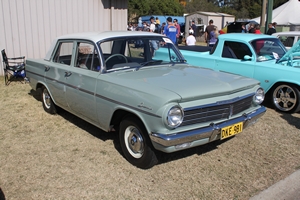|
By accessing/using The Crittenden Automotive Library/CarsAndRacingStuff.com, you signify your agreement with the Terms of Use on our Legal Information page. Our Privacy Policy is also available there. |

The success of the EH Holden 1963
|
|---|
|
|
The success of the EH Holden 1963
Ellie Stewart
24 March 2021
 Holden EH Special (CC-BY) Holden EH Special (CC-BY)
|
Between 1963 and 1965 the Holden sold 250 000 of the EH Holden model. Launched to take on the Ford Falcon, consumers took the bait. They loved the mix of style with power the EH Holden offered at an affordable price compared to the competition.
The Holden 179 automatic Special wagon sold for £1336 in 1964, and the automatic Safari was £1445. The three-speed stick shift Safari sold for £1320. Price was one reason the EH was so popular. But also, Chrysler couldn't keep up with the demand for their Valiants. The EH nearly matched performance and ability, and didn’t have a waiting list.
So, what went into the Holden facelift? The new styling was substantial, giving the vehicle a more imposing look compared to its previous siblings. The revised roofline made the most impact, but the refreshed styling effect could be seen from all angles.
Meet the EH Holden’s new ‘Red’ engine
Holden got the market excited with the first engine they had released that used hydraulic valve lifters. The new ‘Red’ motor in the EH Holden came with an oversquare design and a special seven bearing crankshaft. Maintaining the vehicle also became more manageable, thanks to an external oil pump and oil filter.
The EH and Motorsport
Holden dealers Bill Patterson and Bib Stillwell put their heads together and decided that the Armstrong 500 was the ideal space to show the world what the
1964 EH was made of. They agreed that the 179 cu. in. engine should have some modifications, and they put effort into improving both breathing and exhaust. There were discs and a floor change, a four-speed box and other details such as bucket seats and a larger fuel tank to make it race-ready for motorsport.
Holden enthusiasts argue that the EH 179M was mainly developed to measure the popularity of a growing market called 'pseudo-racers’. It proved the demand was there, and so an officially designated EH 225 M-S.4 (with 179 cu. in. engine) was launched.
The S4: A limited-edition sports version
The S4 (EH 225 M-S.4) had a minimal production of 120 – hence its popularity with collectors. It didn't differ much from the EH 225 M, but tweaks included a rear axle ratio of 3.55:1 and a PBR servo brake unit.
They changed the lining of the clutch, and they modified the steering column gearshift mechanism. The tail shaft diameter increased by .25in. and they enlarged the lower half of the fuel tank to boost capacity to 12 gallons. Naturally, braking had to be relooked, and they added competition sintered metal brake liners to the mix. The S4 also boasted twin carburettors (Solex), modifications of the cylinder head and a more robust clutch and tail shaft.
A secret project
Code-named ‘S22’, the project included five prototypes. They pitched the idea of a model run. It was only 100, but this made it eligible to compete in the 1964 Armstrong 500. The execs chose not the release the competition car ultimately. This was a pity because the new engine was said to develop 135 bhp, reaching a top speed of 110 mph. The S5 was made with only ten prototypes. The word was that it was built to test production facilities, but the plan was really for GM-H dealers to enter the racing S5 in the Armstrong. Although they never saw the race track, the cars later formed the basis of the 179 manual Holden.
A missed opportunity for the S4
When Bathurst 1964 rolled around, it was clear that it would have won if the S4 had made an appearance. Compared to the Cortina GT, it came up trumps with acceleration and speed. The Holden competition version could have reached 120 mph had it raced. The execs were no doubt trying to protect their ‘no competition’ image. Instead, the less powerful 179 version had to compete and lost to the GT Cortina. It was a disappointment, but for Holden fans, there was a silver lining - Holden was showing an interest in racing which could only grow.

















 Holden EH Special (CC-BY)
Holden EH Special (CC-BY)
